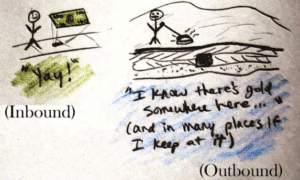6 Keys of Customer Success
like salespeople, customer success is an investment that should make money, not a cost to be put off as long as possible
.
Do you retain 95% of your customers month-to-month? That sounds like something to be proud of – until you do the math. That’s 5% churn per month, or 60% per year. In other words, you have to replace 60% of your revenue every year just to break even. What if you have monthly 98% retention/2% churn? That’s still 25% a year, or a quarter of your revenue.
The best-run SaaS companies can see up to -2% churn per month (on a revenue basis). Yes, that’s negative 2%, which means they make more money every month. How?
Because the customers who stay with them buy and spend more over time than what the company loses from other customers leaving. If you’re a CEO, take Customer Success as seriously as marketing, sales or product development with these rules:
6 Keys of Customer Success
Rule 1. Customer success is your core growth driver.
All great companies’ customers come from one main source – word-of-mouth, whether the leads come via referrals directly, or whether new customers are closed using case studies, references or testimonials. This is much more me assurable in recurring revenue models, where we can track renewal rates, upsell-amounts and referrals.
Rule 2. Customer success is 5x more important than Sales.
Yes – Sales is your priority. But Sales only helps begin what will hopefully be a longer-term relationship. To function at all, Sales needs Customer Success resources – like references, stories and case studies. Generally, founders do a good job of doing whatever it takes to get a big deal closed – but often they do a poor job of everything after that, be cause they’re off to help with the next fire, drama or Big Deal. CEOs and founders: don’t focus on getting new customers so much that you ignore your current customers.
Rule 3. Start early, hire early.
 In SaaS, Customer Success is a “single-digit hire” – one of the first 10 hires. Another SaaS rule of thumb is having one Customer Success manager per $2M in revenue – hired in advance of that revenue, not after you have it. Silicon Valley companies with enough funding often now invest big at the beginning, with 2 to 4 people on the team right away. Remember, a Customer Success person, like a salesperson or a marketing budget, is an investment that should make money (a lot); it’s not just a cost to be put off as long as possible.
In SaaS, Customer Success is a “single-digit hire” – one of the first 10 hires. Another SaaS rule of thumb is having one Customer Success manager per $2M in revenue – hired in advance of that revenue, not after you have it. Silicon Valley companies with enough funding often now invest big at the beginning, with 2 to 4 people on the team right away. Remember, a Customer Success person, like a salesperson or a marketing budget, is an investment that should make money (a lot); it’s not just a cost to be put off as long as possible.
Rule 4. Visit customers in person.
Unhappy customers don’t (always) complain before they leave. In-person visits can make all the difference in identifying their problems and in changing their attitudes. Here’s my personal 5+2 rule on this point – for every co-founder, the CEO, plus every Customer Success Manager:
– Must meet onsite with five customers a month (that’s 60 per year) and
– Get two customer badges every year as a bonus (that is, you visit so often they give you your own ID badge.)
A phone call is not a meeting. By visiting in person, regularly, your company will learn more about what’s really working or not, earn more trust – and those customers will (almost) never churn. It’s much harder to tell a friend you’re leaving them than some faceless company. What if you have nothing to say? Just show them your roadmap and ask for feedback on it, and on issues they are having today. That alone will fill the meeting.
Rule 5. Customer Success needs financial responsibility and metrics.
When your Customer Success function doesn’t have financial goals, its value can get muddled. One bad assumption is that “a great product will automatically create happy customers,” and therefore you won’t need to hire people to actively work with your customers. However easy or incredible your product is, you need humans talking to select categories of your customers.
The whole point of Customer Success is to increase Net Negative Churn, so you need tools and processes to measure and improve the function, including how the people on your team perform. To justify investment (such as in headcount or tools), and to create the hunger that a Customer Success leader and team will need in order to deliver measurable results, Customer Success needs to own some financial results: usually at least on retention rates and perhaps even on upsell revenue.
Rule 6. Evolve Customer Success goals and metrics as you grow.
- Traction ($0-$1M): What do customers want, and what do they do with our product?
- Adoption ($1M-$5M): Why and how should customers include our product in their daily business?
- Retention ($5M-$20M): Why do customers need to keep on using our product after the honeymoon?
- Expansion ($20M-100M): Why should customers expand to more seats, more features?
- Optimization ($100M+): Automation and improvements driven by data.
for more, check out this case study from my new book co-written with jason lemkin, “From Impossible to Inevitable”.
thanks,
– air